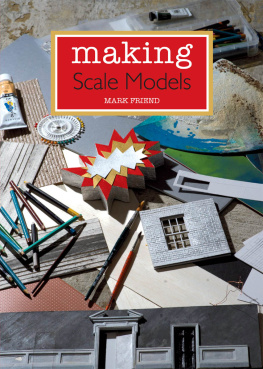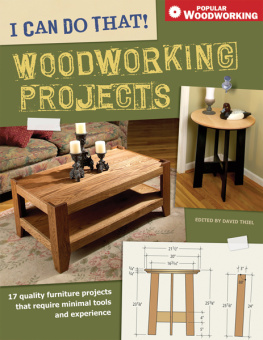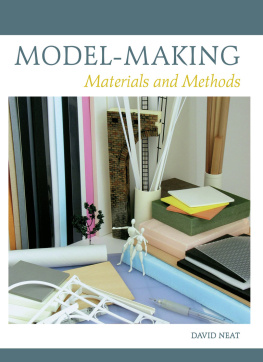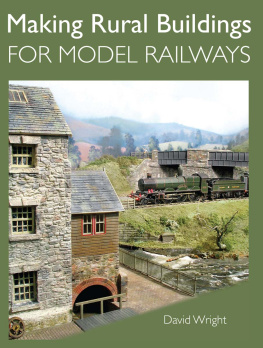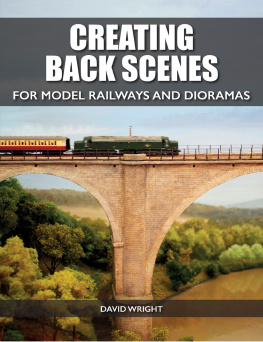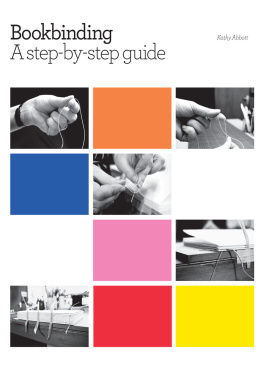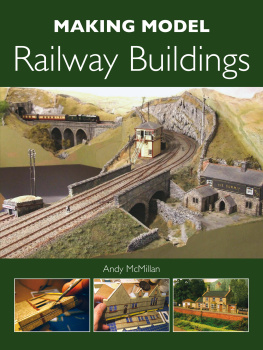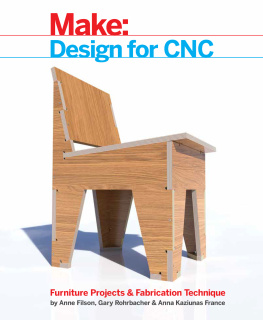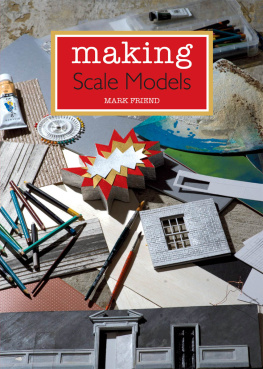CHAPTER ONE
TOOLS AND MATERIALS
TOOLS
Blades
Lets begin with the basics. You will need a sharp blade, a straight edge to cut against, a means of measuring and a way of describing curves and circles. The easiest way to cut through a variety of materials is to use a scalpel handle that takes a size 10a blade, commonly known as a surgical blade or Swann-Morton. There are two types of handle, a plain metal one and a plastic-coated one. Both are lightweight and very flexible. As you become more practised you will find that you draw rather than cut and these are the best tools for the job. The plastic-coated one is a little thicker but it can be easier on the hand, especially if you work for several hours. Though a conventional craft or Stanley knife is a useful tool, do not be tempted to use it as a substitute for a scalpel handle and blade; it is too heavy duty and you will never achieve the lightness of touch that is needed for fine, accurate cutting. The same goes for those sliding, disposable blades that are often sold in discount shops. Both of these are useful but the 10a should be the model makers first choice.

Basic tools: always use a sharp blade.
The Swann-Morton handle will also take a variety of other types of blades of varying length and shape; there is a particular curved blade used for creating lino-prints. These handles were originally designed for surgeons, whose work is not that dissimilar to a skilled model maker!
Saws
While a junior hacksaw is really designed for cutting metal you may find you use it for most larger cutting jobs. Modelling suppliers sell various other saws and jigs (jigs hold the material to be cut and guide the blade). The other type of saw that you may find useful is a bead saw, which is a bit like a very fine hacksaw and is designed for fine woodwork.

Scalpel handles, blades and saws.
Pliers
As with saws, there are all sizes of pliers but a small pair with a long, round nose are the most useful. You can bend metal and wire as well as hold small materials or components steady while you glue or paint them. (Tweezers can be used for this too). A larger, heavier duty set of pliers is useful for cruder tasks and some include a blade for cutting wire and thin metal rod. However, you can get a pair exclusively for cutting.

Steel rules, try squares and a click pencil for accuracy.
Rulers and straight edges
You will need a metal ruler to cut a straight edge. A 12-inch/300mm ruler is a good flexible size but I recommend getting a 6-inch/150mm one for small work and a 1000mm or metre rule as well. You will need this for larger scale work, for instance, if you are constructing a foam board box to protect your model or to cut long strips of any sheet material.
There are a variety of manufacturers who make steel rules. Choose a rule that is not too heavy, but sturdy enough not to bend and slip. Some come with a thin, cork layer on the bottom edge to help grip, although this does mean it is slightly raised and this may cause you to cut an irregular line. My Heath Robinson tip is to get a flat steel rule and stick a piece of masking tape on the side that you are least likely to use for measuring (preferably the side with imperial measurements as from now I will use only the metric system). The tape causes enough friction to stop the rule sliding around, particularly if you are cutting a shiny sheet material, such as clear acetate or mirrored plastic. Just renew the tape from time to time. Use lighter fuel or a commercial product such as Clean Art to get rid of any gluey layers.
In addition, a flat, clear, plastic ruler with a grid printed on it can help with accurate positioning and right angles, though you shouldnt rely on this exclusively. The essential tool for this is discussed next.
Metal squares
As with rulers it is possible to get a variety of sizes of square (or try square to use its full title) for the accurate cutting of a 90-degree angle. While a conventional, woodworkers square with a wooden handle is useful; once again the model maker needs something a little more sophisticated. A small, metal square is best. Not only will it help ensure that you cut perfect 90-degree angles but it will also come in useful to check that any verticals are also correct, for instance, a series of square columns or uprights in an architectural model or the sides of a cuboid. You may need to check the internal angles when constructing a frame and you can even use it as a temporary support in a theatre model. For example, you may want to experiment with positions of walls or free-standing surfaces in a modelled space.
Cutting mats
The correct cutting surface is as important as the correct blade. This means investing in a cutting mat. These consist of a rubber-like material that heals itself when you have cut on it. They usually come in a variety of sizes and in some neutral shade that is restful to the eye. I am currently using a blue one with a white grid pattern on it, rather like graph paper. This can be useful for checking your right angles and whether that spare off-cut of card you are about to use is, in fact, square! I tend to carry an A4 cutting mat in my bag along with a scalpel and ruler, as well as my laptop! The mat ensures a non-slip working surface and prolongs the life of the blade. NEVER use a sheet of MDF, card or ply as a cutting surface. Your blade will be blunt in seconds and your work will suffer.
The right kind of pencil
While accuracy is ultimately achieved when cutting lines or shapes, it is essential that any marking out or measuring beforehand is also done with care. This means using a pencil that will give a consistent and clear mark. For this it is best to use a mechanical or click pencil that takes a 0.5mm lead, rather than an ordinary pencil that needs sharpening regularly and may produce an irregular line. An HB lead is fine if used lightly. If you want something a little softer then use B grade but be careful not to press too hard as it will snap easily. Be careful also not to smudge the line. For very accurate drawing, H grade is good, but it can be difficult to see and it is tempting to press too hard and accidentally score the surface, if using card or wood sheets, such as obeche. This can be a problem if youve made a mistake and want to rub out the line.
Circles and curves
As well as straight lines, you will need to create circular shapes and curves. Pairs of compasses come with a blade attachment in place of the lead but I find them difficult to control. If the blade isnt of premium sharpness, it can snag. Far better I think, to draw the circle using a pair of compasses and then practise cutting a perfect circle. As well as achieving the end result of a disc, repetition of this method helps perfect all the techniques needed for good model making; lightness of touch, concentration and a flair for accuracy.
When it comes to creating ovals and other regular curves such as rounded corners, then arm yourself with as many geometrical tools as you wish. This isnt cheating! There are any number of templates and curves available. Especially useful are the ones for drawing small circles. Attempting to draw these with a pair of compasses can be very tricky. If you want to create a curve without geometry or mathematics but still need some help with drawing it free-hand, use a flexible curve. This is a bendy length of rubber-like material that has a metal core. It can hold any curved shape and you can draw along the line and cut it accordingly.

